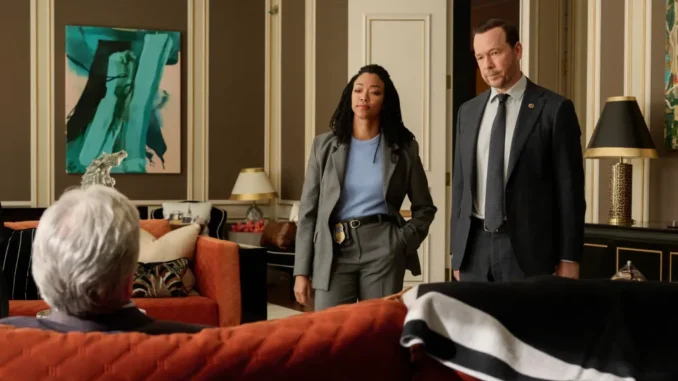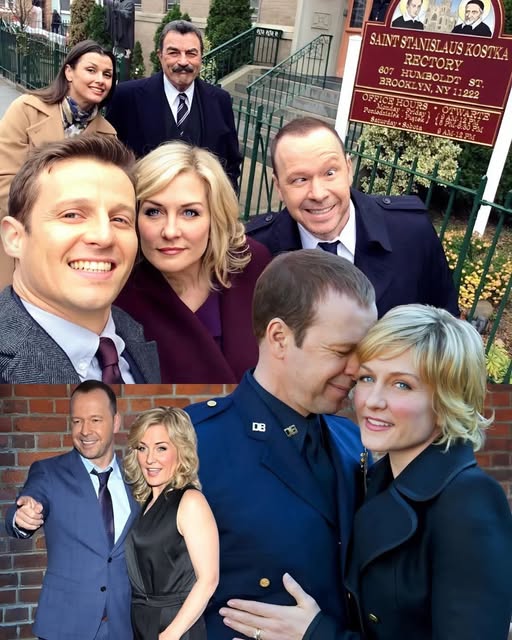
The arrival of Boston Blue marks a defining moment for CBS as it transitions from one of its most enduring dramas, Blue Bloods, into a new phase of storytelling. For fourteen seasons, Blue Bloods anchored the network’s Friday-night lineup, blending police procedural drama with a multi-generational family narrative that resonated with millions of viewers. With Boston Blue now on the air, fans and industry insiders alike are speculating about whether other familiar faces from the original series might eventually return.
At its core, Boston Blue is designed as both a continuation and reinvention. The story follows Detective Danny Reagan, portrayed once again by Donnie Wahlberg, who relocates to Boston after decades with the NYPD. There, he joins a new department and begins working alongside Detective Lena Silver, the daughter of a prominent law-enforcement family. The series introduces the Silver family as the new moral and professional anchor, echoing the Reagan dynamic but within a distinctly Bostonian framework.
Yet despite the introduction of a fresh cast, the gravitational pull of Blue Bloods’ legacy remains strong. Fans have developed deep emotional attachments to the original Reagan family: Frank (Tom Selleck), Erin (Bridget Moynahan), Jamie (Will Estes), and Henry (Len Cariou). Each character represented a generational view of justice and integrity, and their absence in Boston Blue leaves a noticeable void — one that the producers seem fully aware of.
While the show’s creators have emphasized that Boston Blue must succeed on its own terms, the door for returning cast members remains open. In television franchising, familiar faces often serve as narrative bridges that link old and new audiences. Similar strategies have proven successful in other network expansions, allowing established universes to grow while rewarding loyal fans with moments of continuity.
If and when additional Blue Bloods characters return, the approach will likely be gradual and organic rather than immediate. A logical entry point could involve interagency cooperation — cases that span between Boston and New York — offering opportunities for brief crossovers or joint investigations. This framework would allow guest appearances without disrupting Boston Blue’s core storylines or overshadowing its new cast.
Bridget Moynahan’s Erin Reagan, now a prominent legal figure, could easily appear in a multi-jurisdictional case or as a voice of counsel for Danny during his adjustment period. Will Estes’ Jamie Reagan, who ended Blue Bloods as a seasoned NYPD sergeant, could be reintroduced through law-enforcement collaboration, reflecting his long-standing partnership with his brother. Even Len Cariou’s Henry Reagan could return in a sentimental capacity — through phone calls, letters, or flashbacks that tie Danny’s emotional journey to the values instilled by his grandfather.

These potential appearances would not only satisfy long-time fans but also reinforce the themes that made Blue Bloods successful: loyalty, morality, and the enduring influence of family. CBS understands the emotional investment its viewers have in these characters. It’s unlikely the network will abandon that goodwill entirely. Instead, it seems poised to leverage it carefully, allowing Boston Blue to evolve while remaining tethered to the foundation that made its predecessor a staple of network television.
From a production standpoint, Boston Blue is part of CBS’s broader strategy to sustain its procedural brand through interconnected universes. The network has long relied on familiar franchises — from NCIS to FBI — using crossovers and shared characters to maintain audience engagement. The Blue Bloods universe, with its recognizable tone and established fan base, represents another opportunity to extend that formula.
The challenge, however, lies in balance. Leaning too heavily on nostalgia risks undermining Boston Blue’s identity; ignoring it entirely risks alienating the show’s core audience. The series’ success may depend on how seamlessly it can integrate legacy elements while carving out new creative space. Donnie Wahlberg’s continued involvement offers a bridge of authenticity — his character embodies the Reagan legacy while simultaneously charting new territory.
As the first season unfolds, industry analysts expect CBS to monitor audience reactions closely. Viewer enthusiasm for legacy crossovers could influence future creative decisions, potentially shaping the trajectory of the Boston Blue universe. If ratings remain steady and critical response improves, fans may see a gradual reemergence of the Reagan family in cameo or recurring form.
Ultimately, Boston Blue represents both an ending and a beginning. It is an acknowledgment that Blue Bloods’ influence still resonates while signaling CBS’s intent to evolve its storytelling for a new generation. The possibility of returning cast members remains one of the most tantalizing prospects for viewers who spent over a decade at the Reagan family dinner table. Whether those familiar faces return as guest stars or simply as memories woven into dialogue, their presence — literal or symbolic — ensures that the spirit of Blue Bloods continues to guide this new chapter.
